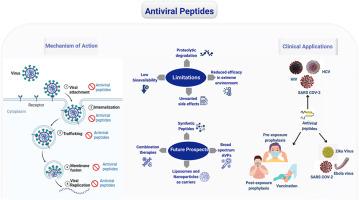利用抗病毒肽:从分子机制到临床翻译
Q2 Agricultural and Biological Sciences
Current Research in Pharmacology and Drug Discovery
Pub Date : 2025-01-01
DOI:10.1016/j.crphar.2025.100228
引用次数: 0
摘要
病毒感染继续对全球健康构成重大威胁,特别是随着耐药病毒株的出现和重新出现。传统抗病毒疗法的局限性,如窄谱活性、高毒性和耐药性上升,强调了创新治疗策略的必要性。抗病毒肽(AVPs)由于其广谱抗病毒活性、低细胞毒性和靶向病毒生命周期多个阶段的能力而成为一种有前景的治疗药物。本文综述了avp的分类、作用机制和临床相关性。讨论了天然和合成avp,包括fda批准的药物,如恩孚韦肽(HIV)和博昔韦(HCV),以及目前正在临床试验的候选药物。avp抑制病毒附着、融合、复制和组装,同时也调节宿主免疫反应。它们的应用不仅限于治疗,还包括预防和联合治疗,为大流行的防范提供了潜在的好处。然而,酶降解、低生物利用度和高生产成本等挑战限制了它们的临床转化。肽工程、计算药物设计和基于纳米颗粒的递送系统的最新进展旨在克服这些障碍。avp代表了一类很有前途的抗病毒药物,有可能解决当前的治疗空白并改善未来的疫情应对。本文综述了它们在抗病毒治疗领域日益增长的重要性,并概述了未来的研究和发展方向。本文章由计算机程序翻译,如有差异,请以英文原文为准。

Harnessing Antiviral Peptides: From Molecular Mechanisms to Clinical Translation
Viral infections continue to pose a significant threat to global health, especially with the emergence and re-emergence of resistant viral strains. The limitations of conventional antiviral therapies, such as narrow-spectrum activity, high toxicity, and rising resistance, underscore the need for innovative treatment strategies. Antiviral peptides (AVPs) have gained attention as promising therapeutic agents due to their broad-spectrum antiviral activity, low cytotoxicity, and ability to target multiple stages of the viral life cycle. This review provides a comprehensive overview of AVPs, focusing on their classification, mechanisms of action, and clinical relevance. Both natural and synthetic AVPs are discussed, including FDA-approved agents such as enfuvirtide (HIV) and boceprevir (HCV), along with candidates currently in clinical trials. AVPs inhibit viral attachment, fusion, replication, and assembly, while also modulating host immune responses. Their applications extend beyond treatment to include prophylaxis and combination therapies, offering potential benefits in pandemic preparedness. However, challenges such as enzymatic degradation, poor bioavailability, and high production costs limit their clinical translation. Recent advances in peptide engineering, computational drug design, and nanoparticle-based delivery systems aim to overcome these barriers. AVPs represent a promising class of antiviral agents with the potential to address current therapeutic gaps and improve future outbreak response. This review highlights their growing importance in the field of antiviral therapy and outlines future directions for research and development.
求助全文
通过发布文献求助,成功后即可免费获取论文全文。
去求助
来源期刊

Current Research in Pharmacology and Drug Discovery
Agricultural and Biological Sciences-Animal Science and Zoology
CiteScore
6.40
自引率
0.00%
发文量
65
审稿时长
40 days
 求助内容:
求助内容: 应助结果提醒方式:
应助结果提醒方式:


